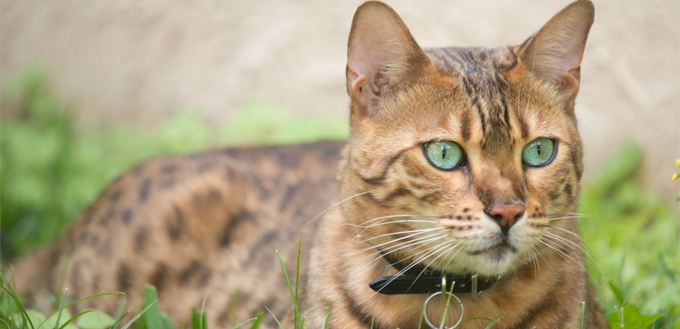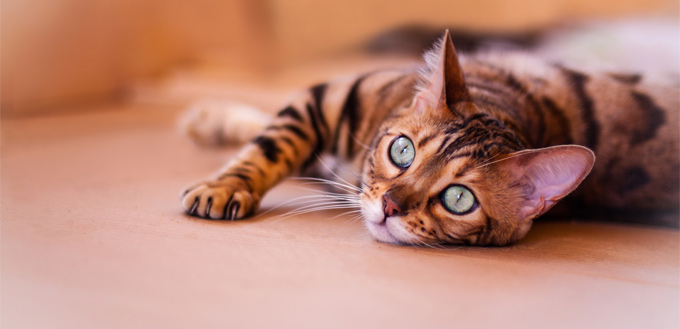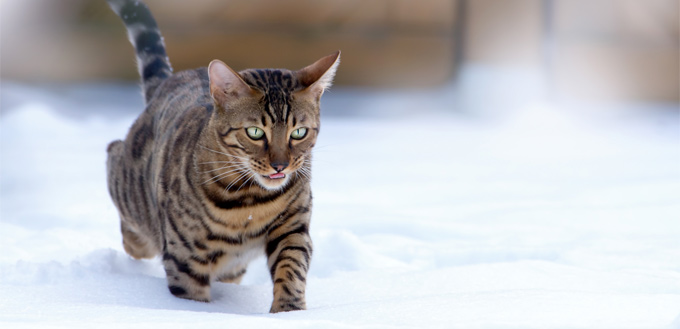History of the Bengal Cat
If this is the first time you’ve heard of the Bengal cat, you might think it’s a miniaturized version of the Bengal tiger. Sure, it has some of the classic stripes of the most famous large cat in the wild, but it also has the spots of a leopard. But the truth is that the Bengal cat got its name not from the geopolitical region of South Asia of the same name but rather from the scientific name of one of its progenitors, the Prionailurus bengalensis bengalensis. This is the Asian leopard cat. It should never be confused with the leopard which belongs to the genus Panthera.
The Asian leopard cat is as small as a domestic cat but with a slenderer body and longer limbs than its domesticated cousins. In between its toes are well-defined webs. This domestic-cat like wild feline is mostly found in South, East, and Southeast Asia while the leopard is more of an African large wild cat.
The Bengal cat was developed by crossbreeding the Asian leopard cat with a domesticated feline. The cross-breeders hoped to create a cat that has all the exotic physical characteristics of an Asian wildcat while retaining the friendly, healthy, and confident temperament of a domestic cat. In short, the Bengal was developed primarily to wow the crowd.

We are not really sure when the first hybrid was created, although there are stories about Harrison Weir writing about the crossbreeding in the book “Our Cats and All About Them” published in 1889. However, this was disputed by C. Boden Kloss in 1927 who said that he has never heard of such crossbreeds in the Malayas. He did mention observing local tribeswomen breastfeeding Bengalensis kittens. He cannot, however, recall if the wild tribe also crossed these Bengalensis cats with other cats. The subject of hybridization between a wild Bengalensis and a domestic cat was, nevertheless, confirmed in a Belgian scientific journal in 1934.
The first Westerner who is largely credited for the breeding of a Bengal cat was Jean Mill in the 1940s. Mill acquired a Bengalensis to serve as a companion for her black tom cat. The two inadvertently mated and produced spotted kittens. She retained one female and mated it back with its father, resulting in a combination of solid and spotted kittens. This became the subject of her term paper for her genetics subject at the UC-Davis.
About 3 decades later, Willard Centerwall crossbred Bengalensis with domestic felines hoping to pass the Asian leopard cat’s immunity to feline leukemia onto the resulting kittens. When Centerwall got seriously ill, Mill continued on his hybridization program. She sourced a house cat with orange shorthair and a brown spotted tabby to be used in the crossbreeding.
Mill was not content on the crossbreeding of the Bengalensis, however. As such, she instituted a strict program of in-breeding to solidify the characteristics sought in the breed. In 1983, Mill’s work paid off with the recognition by the International Cat Association of the Bengal Cat as an experimental breed. The Bengal finally earned its full recognition as a breed in 1991.
The Bengal cat is one of the world’s most sought-after felines. They earned the nickname “Rolls Royce” of all kitty companions when a British woman was reported to have bought a Bengal for a whopping $50,000 price tag in 1990.
Quick Facts About the Bengal Cat Breed
The Bengal may have started as a hybrid between a wild cat and a house cat, but it sure is one of the best-domesticated felines in the market today. It has the exotic features of an Asian leopard while retaining the playfulness and friendliness of a house kitty. Here are some pieces of information that you need to know about this feline breed.
- The Bengal can weigh as heavy as 15 pounds, although should never be lighter than 8 pounds
- It has a lifespan of about 10 to 16 years
- Its head has a modified wedge shape which is broader at the head and narrower towards the chin. The contours are always rounded, though.
- The ears are small to medium in size and are usually set towards the side of the Bengal’s head.
- The eyes take on an oval but mostly rounded shape.
- The body of a Bengal is strong and muscular; more of the athletic type.
- The coat of the Bengal is dense and comes with soft and silky fur.
- The Bengal’s coat can have different colors including seal mink tabby, seal silver lynx point, brown tabby, and black silver tabby.
- It can also have different patterns like horizontal stripes, leopard-like spots, and marbled. Some Bengals have been observed to take on a coat that is ‘glittered’ as it shimmers like a gem when the light is reflected off the coat.
- The limbs are of medium length, although the hind legs are always longer than the pair up front.
- The Bengal is a low-shedding, mildly allergenic cat that is easy to groom.
- It has a very high activity level and is very sociable even to dogs.
Things You Should Know
To say that the Bengal is an exotic cat is an understatement. It is a feline marvel that is full of pride and joy and loves nothing else than to explore the world around it. It’s understandable why you may want to get a Bengal for your family, especially if you have the financial resources for it. Mind you, this is a cat that will set you back a couple of thousands of dollars for a good quality purebred. Other than that, you should also consider the following things:
Health
Although the Bengal is known to have inherited the Asian leopard cat’s immunity to feline leukemia, it doesn’t protect it against other potential kitty diseases. These can include hypertrophic cardiomyopathy, anesthetic allergies, cataract, luxating patellas, progressive retinal atrophy, kidney problems, and issues of the skin and coat.
Hypertrophic cardiomyopathy is an inheritable disease that is considered by many as a recessive trait. As such, the clinical presentation of the disease typically follows a ‘skipped generation’ pattern. For example, if the grandparents of the Bengal presented with the condition, its parents will not have the disease since it ‘skipped’ their generation. Unfortunately for the Bengal, it will have the disease. Of course, this is oversimplification of a recessive type of disease. Hypertrophic cardiomyopathy often leads to heart failure because the cat’s heart is no longer able to meet the metabolic demands of its body. And since the Bengal is such a hyperactive kitty, the implications can be devastating.
Cataracts and progressive retinal atrophy in this cat can always lead to problems in its vision. While these conditions can be managed with surgery, it also exposes the kitty to another problem – anesthetic allergy. Nobody knows why, but the Bengal has shown puzzling allergic reactions to anesthetic agents.
In luxating patellas, the kneecap of the kitty is not in its normal anatomical position. This leads to lameness and can also predispose the Bengal to degenerative arthritis. The good news is that if it is not very severe, the condition can be managed by controlling your kitty’s weight. Otherwise, your vet may need to cut your Bengal open to fix the out-of-place patella.
Other diseases that may affect a Bengal include distal neuropathy, hip dysplasia, and flat-chested kitten syndrome.

Feeding
Bengals need high-quality cat food that places emphasis on animal proteins. It is perfectly alright to get a kitty diet that comes with plant proteins, but these should not be the principal ingredient since they often come with incomplete amino acids like taurine.
Related Post: Best Wet Cat Food
Since Bengal has a high activity level, it is important to look at the calorie content of the food you’re giving it. But if you’re going to turn your kitty into a lazy cat, you should go slow on calorie-dense diets. This is important especially if the Bengal has luxating patellas. Food control and weight management are two key ingredients to managing this health condition in this exotic kitty.
Related Post: Best Cat Food For Bengals
Care
Training is an important aspect of the care of a Bengal cat. This is a very intelligent feline that requires plenty of highly stimulating activities. If not, it will grow bored and can shred your stuff into pieces.
The Bengal has a special affinity for water. This kitty is never afraid to dip its paws in a bowl of water or even snatch a goldfish straight out of your aquarium. Water-related activities are always considered as very fun and enjoyable for this exotic breed of cat. On the lighter side, it should be fairly easy to give a bath as it doesn’t mind getting wet.
Like all kitties, the Bengal wants its toilet to be spick and span. That being said, you should make it a point to clean its litter box on a regular basis. If there is poop or clumped litter you should remove this immediately, otherwise the Bengal will put its business somewhere else.
Related Post: Best Cat Litter Box
The Asian leopard cat in the Bengal is especially strong. It will scour the backyard for anything that can catch its interest. It will climb trees and other structures like the leopard of the wild. As such, building a large enclosure right in your backyard is often recommended as this will be the ‘playground’ of the Bengal.
We don’t recommend letting your Bengal go outside your home. It’s an exotic and really beautiful cat that is a magnet for cat thieves. Besides, the outdoors is full of risks for your elegant pet.
Grooming
With its short yet thick coat, you’d think the Bengal will be very difficult to groom. Surprisingly, it isn’t. It will only need weekly brushing just so you can remove any loose dead hair. Brushing can also help distribute the natural oils on its skin a lot better, allowing for the improved protection of its skin.
Related Post: Best Cat Brush
The nails of the Bengal should always be inspected every two weeks and clipped if it is already long. The same is true with its eyes and ears. Since cataracts and other eye problems are a major concern for this kitty, weekly inspection of its eyes is a must. The corners of its eyes should be wiped clean. The Bengal also requires daily brushing of its feline teeth, although we do recognize the inconvenience or impracticality of doing so. As such, you can brush the teeth at least 2 times per week.
Related Post: Best Cat Ear Cleaner

Temperament
The Bengal is friendly and confident. It is not the silent type of cat that you can expect to stay in one corner of the home and will still be there by the time you come home from work. It is an active fellow; a feline that enjoys exploring the little world around it. It is like a guard dog, except that it is a cat. Nothing escapes the inquisitive and alert nature of the Bengal. It is a trait that it got from its Bengalensis ancestors. It is playful and very active and can relish physically demanding games as much as it enjoys playing with kids. It is very intelligent, too, fully capable of learning tricks.
It thrives on the attention given by its master. As such, if you fail to give it the attention that it needs, it will create a scene to make sure that you notice it. It will fish your aquatic pets out of the aquarium, turn the lights on and off, and even snatch some things in the kitchen and bring these to your feet. It loves to entertain. And it is happiest when its human master interacts with it. It is for this reason that the Bengal cat is not really recommended for folks who cannot find time to spend with their kitties.
The Bengal may be sweet and friendly, but it’s not the type of gentle lap cat that will never require interaction from its human owner. It’s very active and thrives on the attention that is given to it by its human family. If you can meet this requirement plus have extra budget to spare, then the Bengal may be for you. After all, it’s not every day you get to bring home a mini leopard.
Sources:
- Bengal House Cat, PetMD
- Benga, VetStreet
- Benga, VCA Hospitals
More Pet Product Reviews
Heated Cat Beds
Cat Collars
Cat Costumes
Cat Doors
Laser Pointers for Cats
Cat Litter Boxes
Cat Condos for Kitties
Cat Window Perches
Cat Litter
Interactive Cat Toys






